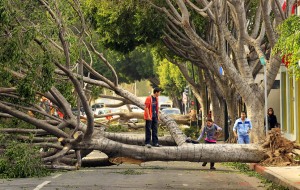City of Pasadena Potentially Liable for Property Damage Caused by Its Trees

The City moved for summary adjudication before the trial court arguing that a “tree was not a work of public improvement that is the proper subject of an inverse condemnation action”; and for the private nuisance claim, that there was no evidence that the City was negligent. The trial court denied the motion, finding that the “subject tree is part of a work of public improvement” and that evidence of negligence is not required in a nuisance claim. The City appealed and presented the same arguments to the Court of Appeal.
Regarding the claim for inverse condemnation, the Court of Appeal found that the “sole issue here is whether the City’s public tree, as part of the City’s forestry program, constitutes a public improvement such that it could provide the basis for an inverse condemnation claim.” (Slip op. at 6).
The Court of Appeal denied the appeal, reasoning that the City owned the tree and actively managed its tree population:
“Here, the evidence presented by the City in support of its motion for summary adjudication did not demonstrate that there was no triable issue of fact as to whether the subject tree was a part of a public improvement. The City’s separate statement stated only that, on November 30, 2011, a tree owned by the City fell on the residence of Mercury’s insured. In the supporting declaration by the City’s arborist, the arborist said that he managed the maintenance of 60,000 street trees including the subject tree, that the City catalogued these trees in a database, that he “headed an urban tree maintenance program,” and that “[t]he City strives to enhance the quality of life through the promotion, protection, and balanced management of … trees.”
“This evidence showed that the subject tree was a street tree that was part of a City program to enhance its residents’ and visitors’ quality of life through the maintenance of trees in the City. It showed that the City took deliberate actions to manage the program by cataloging its trees and maintaining them through regular pruning. In addition, as in Regency Outdoor Advertising, the tree here was part of a government program to maintain trees along roads and, thus, served the public purpose of improving public roads. This evidence was sufficient to demonstrate a triable issue of fact as to whether the tree, as part of the forestry program, constituted a public improvement.” (Slip op. at 9).
We’re sure the City will appeal to the California Supreme Court, but, for now, it’s the law of the land in California.
So, let’s assume that the State of New Jersey constructs a system of dunes along the Atlantic coast-line allegedly designed to protect private property from the ravages of a rising sea and more frequent storm-surges (like Superstorm Sandy, Hurricane Katrina, Hurricane Irene, etc.) And instead of taking fee ownership of the dune system, the State insists that the coastal property owners “give” the State an easement to permit the construction and improvements necessary for the project.
Five years later, the next storm arrives and the State has failed to properly maintain the dunes (b/c federal money is no longer available), and coastal private property is damaged. Under City of Pasadena, the State would be liable for the damages caused. Food for thought.
We’ll keep you posted.






